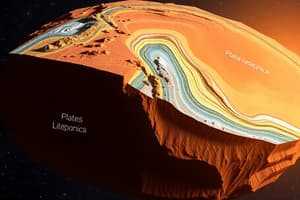Podcast
Questions and Answers
What geological feature is formed as a result of the collision of two continental plates?
What geological feature is formed as a result of the collision of two continental plates?
- Mid-ocean ridges
- Volcanic islands
- Mountain ranges (correct)
- Oceanic trenches
What is the primary cause of tectonic plate movement?
What is the primary cause of tectonic plate movement?
- Gravitational pull from the moon
- Earth's rotation
- Wind currents in the atmosphere
- Convection in the mantle (correct)
Which of the following boundaries typically results in the formation of volcanoes?
Which of the following boundaries typically results in the formation of volcanoes?
- Transform boundaries
- Divergent boundaries (correct)
- Hot spot regions
- Continental-continental boundaries
What characterizes a transform plate boundary?
What characterizes a transform plate boundary?
In which region are the Himalayas primarily formed due to land feature collisions?
In which region are the Himalayas primarily formed due to land feature collisions?
What is the primary reason tectonic plates are significant in relation to earthquakes and volcanic activity?
What is the primary reason tectonic plates are significant in relation to earthquakes and volcanic activity?
What type of plate boundary occurs when two plates move away from each other?
What type of plate boundary occurs when two plates move away from each other?
Which geological feature is commonly formed at divergent plate boundaries?
Which geological feature is commonly formed at divergent plate boundaries?
What happens when an oceanic plate collides with a continental plate at a convergent boundary?
What happens when an oceanic plate collides with a continental plate at a convergent boundary?
What is formed at a subduction zone when two oceanic plates collide?
What is formed at a subduction zone when two oceanic plates collide?
Flashcards are hidden until you start studying
Study Notes
Plate Tectonics Overview
- Tectonic plates, not continents, move at 1 to 10 centimeters per year, floating on the asthenosphere.
- Approximately 20 lithospheric plates exist, interacting in various ways.
Plate Boundaries
- The regions where tectonic plates interact are called plate boundaries.
- Plate boundaries are critical because they are often sites of earthquakes and volcanic activity, with most seismic events occurring at three types: divergent, convergent, and transform.
Divergent Plate Boundary
- Occurs when two plates move away from each other, creating a gap or rift.
- Produces mid-ocean ridges and continental rift zones.
- Example: Iceland sits on a divergent boundary between the North American Plate and the Eurasian Plate.
- Example: East Africa Rift Valley, a continental rift.
Convergent Plate Boundary
- Two plates move toward each other, forming subduction zones or orogenic belts.
- Subduction Zone: One plate moves beneath another, leading to volcanic activity.
- Example: Mariana Trench formed by oceanic-oceanic convergence.
- Oceanic-Continental Convergence: An oceanic plate collides with a continental plate, leading to trench formation and volcanism.
- Examples: Andes Mountains in South America, Cascade Range in North America.
- Continental-Continental Convergence: Both continental plates collide and push upwards, forming large mountain ranges.
- Examples: Himalayas, European Alps formed from the collision of Africa and Eurasia.
Transform Plate Boundary
- Plates slide past each other, causing earthquakes without forming mountains or volcanoes.
- Example: San Andreas Fault.
Types of Boundaries Summary
- Divergent: Plates moving apart (e.g., mid-ocean ridges like Iceland, continental rift zones like the African Rift Valley).
- Convergent: Plates moving together, resulting in:
- Oceanic-Oceanic (e.g., Japanese Islands)
- Oceanic-Continental (e.g., Andes and Cascades)
- Continental-Continental (e.g., Himalayas).
- Transform: Plates slide against each other (e.g., San Andreas Fault).
- Hotspots, which are not located at plate boundaries, provide insights into plate motion.
Causes of Plate Tectonics
- Plate movement is driven by mantle convection as the plastic asthenosphere flows.
- Mechanisms include slab pull at subduction zones, ridge push at mid-ocean ridges, and rising mantle plumes.
Studying That Suits You
Use AI to generate personalized quizzes and flashcards to suit your learning preferences.




